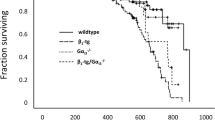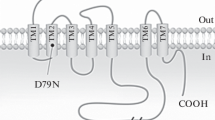Abstract
Heart failure is one of the most common medical diseases—almost every third 55-year-old person in the Western world is going to develop heart failure in his or her life. The development of heart failure is associated with pivotal restructuring of the β-adrenergic system. The β-adrenoceptor antagonists have emerged to be an essential part of the therapy of chronic heart failure. Three different β-adrenoceptors could be identified and characterized so far. The β1-adrenoceptors are being down-regulated, while the β3-adrenoceptors are being up-regulated. The mechanisms that are responsible for the positive impact of β-adrenoceptor antagonists are not completely understood up to now. Therefore, it is necessary to point out the crucial role of the β-adrenergic system for the regulation of the cardiovascular system and the pathogenesis of heart failure. In the recent couple of years, numerous transgenic mouse models have proven to be helpful to gain a better understanding of the function and the relevance of these receptors. This review gives an overview of the pathophysiological relevance of the β-adrenergic system for heart failure and outlines the most important insights concerning heart function, which could be derived from genetically changed mice with chronic deficiency and overexpression of the β-adrenoceptor.

Similar content being viewed by others
References
Ahlquist RP (1948) A study of the adrenotropic receptors. Am J Physiol 153:586–600
Ahlquist RP (1967) Development of the concept of alpha and beta adrenotropic receptors. Ann NY Acad Sci 139:549–552
Azevedo ER, Parker JD (1999) Parasympathetic control of cardiac sympathetic activity: normal ventricular function versus congestive heart failure. Circulation 100:274–279
Bittner HB, Chen EP, Milano CA, Lefkowitz RJ, Van Trigt P (1997) Functional analysis of myocardial performance in murine hearts overexpressing the human beta 2-adrenergic receptor. J Mol Cell Cardiol 29:961–967
Bleumink GS, Knetsch AM, Sturkenboom MC et al (2004) Quantifying the heart failure epidemic: prevalence, incidence rate, lifetime risk and prognosis of heart failure The Rotterdam Study. Eur Heart J 25:1614–1619
Bond RA, Leff P, Johnson TD et al (1995) Physiological effects of inverse agonists in transgenic mice with myocardial overexpression of the beta 2-adrenoceptor. Nature 374:272–276
Bristow MR, Ginsburg R, Umans V et al (1986) Beta 1- and beta 2-adrenergic-receptor subpopulations in nonfailing and failing human ventricular myocardium: coupling of both receptor subtypes to muscle contraction and selective beta 1-receptor down-regulation in heart failure. Circ Res 59:297–309
Brixius K, Bloch W, Pott C et al (2004) Mechanisms of beta 3-adrenoceptor-induced eNOS activation in right atrial and left ventricular human myocardium. Br J Pharmacol 143:1014–1022
Brodde OE, Michel MC (1999) Adrenergic and muscarinic receptors in the human heart. Pharmacol Rev 51:651–690
Bylund DB, Eikenberg DC, Hieble JP et al (1994) International Union of Pharmacology nomenclature of adrenoceptors. Pharmacol Rev 46:121–136
Calaghan SC, White E, Colyer J (1998) Co-ordinated changes in cAMP, phosphorylated phospholamban, Ca2+ and contraction following beta-adrenergic stimulation of rat heart. Pflugers Arch 436:948–956
Chruscinski AJ, Rohrer DK, Schauble E, Desai KH, Bernstein D, Kobilka BK (1999) Targeted disruption of the beta2 adrenergic receptor gene. J Biol Chem 274:16694–16700
Cleland JG, Khand A, Clark A (2001) The heart failure epidemic: exactly how big is it? Eur Heart J 22:623–626
Cohn JN, Levine TB, Olivari MT et al (1984) Plasma norepinephrine as a guide to prognosis in patients with chronic congestive heart failure. N Engl J Med 311:819–823
Cross HR, Steenbergen C, Lefkowitz RJ, Koch WJ, Murphy E (1999) Overexpression of the cardiac beta(2)-adrenergic receptor and expression of a beta-adrenergic receptor kinase-1 (betaARK1) inhibitor both increase myocardial contractility but have differential effects on susceptibility to ischemic injury. Circ Res 85:1077–1084
Dorn GW 2nd, Tepe NM, Lorenz JN, Koch WJ, Liggett SB (1999) Low- and high-level transgenic expression of beta2-adrenergic receptors differentially affect cardiac hypertrophy and function in Galphaq-overexpressing mice. Proc Natl Acad Sci USA 96:6400–6405
Du XJ, Vincan E, Woodcock DM, Milano CA, Dart AM, Woodcock EA (1996) Response to cardiac sympathetic activation in transgenic mice overexpressing beta 2-adrenergic receptor. Am J Physiol 271:H630–H636
Du XJ, Autelitano DJ, Dilley RJ, Wang B, Dart AM, Woodcock EA (2000) beta(2)-adrenergic receptor overexpression exacerbates development of heart failure after aortic stenosis. Circulation 101:71–77
Du XJ, Gao XM, Jennings GL, Dart AM, Woodcock EA (2000) Preserved ventricular contractility in infarcted mouse heart overexpressing beta(2)-adrenergic receptors. Am J Physiol Heart Circ Physiol 279:H2456–H2463
Du XJ, Gao XM, Wang B, Jennings GL, Woodcock EA, Dart AM (2000) Age-dependent cardiomyopathy and heart failure phenotype in mice overexpressing beta(2)-adrenergic receptors in the heart. Cardiovasc Res 48:448–454
Eckberg DL, Drabinsky M, Braunwald E (1971) Defective cardiac parasympathetic control in patients with heart disease. N Engl J Med 285:877–883
Emorine LJ, Marullo S, Briend-Sutren MM et al (1989) Molecular characterization of the human beta 3-adrenergic receptor. Science 245:1118–1121
Engelhardt S, Hein L, Wiesmann F, Lohse MJ (1999) Progressive hypertrophy and heart failure in beta1-adrenergic receptor transgenic mice. Proc Natl Acad Sci USA 96:7059–7064
Engelhardt S, Boknik P, Keller U, Neumann J, Lohse MJ, Hein L (2001) Early impairment of calcium handling and altered expression of junctin in hearts of mice overexpressing the beta1-adrenergic receptor. FASEB J 15:2718–2720
Engelhardt S, Hein L, Dyachenkow V, Kranias EG, Isenberg G, Lohse MJ (2004) Altered calcium handling is critically involved in the cardiotoxic effects of chronic beta-adrenergic stimulation. Circulation 109:1154–1160
Freestone NS, Ribaric S, Scheuermann M, Mauser U, Paul M, Vetter R (2000) Differential lusitropic responsiveness to beta-adrenergic stimulation in rat atrial and ventricular cardiac myocytes. Pflugers Arch 441:78–87
Gauthier C, Tavernier G, Charpentier F, Langin D, Le Marec H (1996) Functional beta3-adrenoceptor in the human heart. J Clin Invest 98:556–562
Gauthier C, Leblais V, Kobzik L et al (1998) The negative inotropic effect of beta3-adrenoceptor stimulation is mediated by activation of a nitric oxide synthase pathway in human ventricle. J Clin Invest 102:1377–1384
Jessup M, Brozena S (2003) Heart failure. N Engl J Med 348:2007–2018
Kaumann AJ, Preitner F, Sarsero D, Molenaar P, Revelli JP, Giacobino JP (1998) (−)-CGP 12177 causes cardiostimulation and binds to cardiac putative beta 4-adrenoceptors in both wild-type and beta 3-adrenoceptor knockout mice. Mol Pharmacol 53:670–675
Kaumann AJ, Engelhardt S, Hein L, Molenaar P, Lohse M (2001) Abolition of (−)-CGP 12177-evoked cardiostimulation in double beta1/beta2-adrenoceptor knockout mice. Obligatory role of beta1-adrenoceptors for putative beta4-adrenoceptor pharmacology. Naunyn Schmiedebergs Arch Pharmacol 363:87–93
Kilts JD, Gerhardt MA, Richardson MD et al (2000) Beta(2)-adrenergic and several other G protein-coupled receptors in human atrial membranes activate both G(s) and G(i). Circ Res 87:705–709
Kohout TA, Takaoka H, McDonald PH et al (2001) Augmentation of cardiac contractility mediated by the human beta(3)-adrenergic receptor overexpressed in the hearts of transgenic mice. Circulation 104:2485–2491
Liggett SB, Tepe NM, Lorenz JN et al (2000) Early and delayed consequences of beta(2)-adrenergic receptor overexpression in mouse hearts: critical role for expression level. Circulation 101:1707–1714
Mackenzie E, Standen NB (1980) The postnatal development of adrenoceptor responses in isolated papillary muscles from rat. Pflugers Arch 383:185–187
MacLennan DH, Kranias EG (2003) Phospholamban: a crucial regulator of cardiac contractility. Nat Rev, Mol Cell Biol 4:566–577
Milano CA, Allen LF, Rockman HA et al (1994) Enhanced myocardial function in transgenic mice overexpressing the beta 2-adrenergic receptor. Science 264:582–586
Milano CA, Allen LF, Dolber PC et al (1995) Marked enhancement in myocardial function resulting from overexpression of a human beta-adrenergic receptor gene. J Thorac Cardiovasc Surg 109:236–241
Muller FU, Kirchhefer U, Begrow F, Reinke U, Neumann J, Schmitz W (2002) Junctional sarcoplasmic reticulum transmembrane proteins in the heart. Basic Res Cardiol 97(Suppl 1):I52–I55
Port JD, Bristow MR (2001) Altered beta-adrenergic receptor gene regulation and signaling in chronic heart failure. J Mol Cell Cardiol 33:887–905
Porter TR, Eckberg DL, Fritsch JM et al (1990) Autonomic pathophysiology in heart failure patients. Sympathetic–cholinergic interrelations. J Clin Invest 85:1362–1371
Pott C, Brixius K, Bundkirchen A et al (2003) The preferential beta3-adrenoceptor agonist BRL 37344 increases force via beta1-/beta2-adrenoceptors and induces endothelial nitric oxide synthase via beta3-adrenoceptors in human atrial myocardium. Br J Pharmacol 138:521–529
Revelli JP, Preitner F, Samec S et al (1997) Targeted gene disruption reveals a leptin-independent role for the mouse beta3-adrenoceptor in the regulation of body composition. J Clin Invest 100:1098–1106
Rockman HA, Hamilton RA, Jones LR, Milano CA, Mao L, Lefkowitz RJ (1996) Enhanced myocardial relaxation in vivo in transgenic mice overexpressing the beta2-adrenergic receptor is associated with reduced phospholamban protein. J Clin Invest 97:1618–1623
Rohrer DK, Desai KH, Jasper JR et al (1996) Targeted disruption of the mouse beta1-adrenergic receptor gene: developmental and cardiovascular effects. Proc Natl Acad Sci USA 93:7375–7380
Rohrer DK, Schauble EH, Desai KH, Kobilka BK, Bernstein D (1998) Alterations in dynamic heart rate control in the beta 1-adrenergic receptor knockout mouse. Am J Physiol 274:H1184–H1193
Rohrer DK, Chruscinski A, Schauble EH, Bernstein D, Kobilka BK (1999) Cardiovascular and metabolic alterations in mice lacking both beta1- and beta2-adrenergic receptors. J Biol Chem 274:16701–16708
Satwani S, Dec GW, Narula J (2004) Beta-adrenergic blockers in heart failure: review of mechanisms of action and clinical outcomes. J Cardiovasc Pharmacol Ther 9:243–255
Schwarz B, Percy E, Gao XM, Dart AM, Richardt G, Du XJ (2003) Altered calcium transient and development of hypertrophy in beta2-adrenoceptor overexpressing mice with and without pressure overload. Eur J Heart Fail 5:131–136
Schwinger RH, Bohm M, Erdmann E (1990) Evidence against spare or uncoupled beta-adrenoceptors in the human heart. Am Heart J 119:899–904
Schwinger RH, Bohm M, Schmidt U et al (1995) Unchanged protein levels of SERCA II and phospholamban but reduced Ca2+ uptake and Ca(2+)-ATPase activity of cardiac sarcoplasmic reticulum from dilated cardiomyopathy patients compared with patients with nonfailing hearts. Circulation 92:3220–3228
Sheridan DJ, Autelitano DJ, Wang B, Percy E, Woodcock EA, Du XJ (2000) Beta(2)-adrenergic receptor overexpression driven by alpha-MHC promoter is downregulated in hypertrophied and failing myocardium. Cardiovasc Res 47:133–141
Steinberg SF (1999) The molecular basis for distinct beta-adrenergic receptor subtype actions in cardiomyocytes. Circ Res 85:1101–1111
Stroe AF, Gheorghiade M (2004) Carvedilol: beta-blockade and beyond. Rev Cardiovasc Med 5(Suppl 1):S18–S27
Susulic VS, Frederich RC, Lawitts J et al (1995) Targeted disruption of the beta 3-adrenergic receptor gene. J Biol Chem 270:29483–29492
Tavernier G, Toumaniantz G, Erfanian M et al (2003) beta3-Adrenergic stimulation produces a decrease of cardiac contractility ex vivo in mice overexpressing the human beta3-adrenergic receptor. Cardiovasc Res 59:288–296
Varghese P, Harrison RW, Lofthouse RA, Georgakopoulos D, Berkowitz DE, Hare JM (2000) beta(3)-adrenoceptor deficiency blocks nitric oxide-dependent inhibition of myocardial contractility. J Clin Invest 106:697–703
Vrydag W, Michel MC (2007) Tools to study beta3-adrenoceptors. Naunyn Schmiedebergs Arch Pharmacol 374:385–398
Wagner KD, Geil D, Schimke I et al (1998) Decreased susceptibility of contractile function to hypoxia/reoxygenation in chronic infarcted rat hearts. J Mol Cell Cardiol 30:2341–2353
Wenzel-Seifert K, Seifert R (2000) Molecular analysis of beta(2)-adrenoceptor coupling to G(s)-, G(i)-, and G(q)-proteins. Mol Pharmacol 58:954–966
Xiao RP, Zhu W, Zheng M et al (2004) Subtype-specific beta-adrenoceptor signaling pathways in the heart and their potential clinical implications. Trends Pharmacol Sci 25:358–365
Zhou YY, Song LS, Lakatta EG, Xiao RP, Cheng H (1999) Constitutive beta2-adrenergic signalling enhances sarcoplasmic reticulum Ca2+ cycling to augment contraction in mouse heart. J Physiol (Lond) 521(Pt 2):351–361
Zhu WZ, Zheng M, Koch WJ, Lefkowitz RJ, Kobilka BK, Xiao RP (2001) Dual modulation of cell survival and cell death by beta(2)-adrenergic signaling in adult mouse cardiac myocytes. Proc Natl Acad Sci USA 98:1607–1612
Ziskoven C, Grafweg S, Bölck B et al (2007) Increased Ca2+ sensitivity and protein expression of SERCA 2a in situations of chronic beta3-adrenoceptor deficiency. Pflugers Arch 453:443–453
Author information
Authors and Affiliations
Corresponding author
Rights and permissions
About this article
Cite this article
Lee, S., Schwinger, R.H.G. & Brixius, K. Genetically changed mice with chronic deficiency or overexpression of the β-adrenoceptors—what can we learn for the therapy of heart failure?. Pflugers Arch - Eur J Physiol 455, 767–774 (2008). https://doi.org/10.1007/s00424-007-0324-1
Received:
Revised:
Accepted:
Published:
Issue Date:
DOI: https://doi.org/10.1007/s00424-007-0324-1




